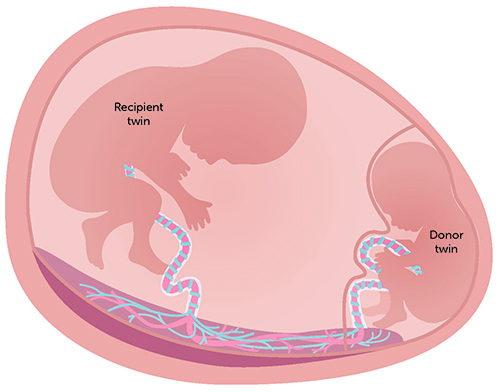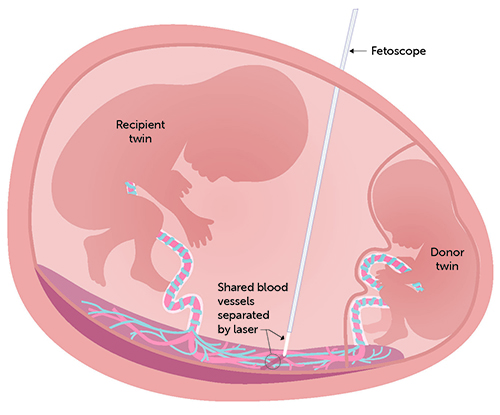Twin-Twin Transfusion Syndrome
OHSU Doernbecher offers advanced care for developing babies with twin-twin transfusion syndrome (TTTS). Our Fetal Care Program is the only one in Oregon with complete care for TTTS. We offer:
- Diagnosis and monitoring by providers who are experts in fetal conditions.
- Complete care and delivery options, for all stages of TTTS.
- Laser photocoagulation, a minimally invasive treatment for TTTS.
- Surgeons with advanced training in fetal surgery will care for you and your developing babies.
Understanding twin-twin transfusion syndrome
Twin-twin transfusion syndrome happens during pregnancy with monochorionic twins. This means they share a placenta. It is rare, and occurs in about 10-15% of identical-twin pregnancies.
In twin pregnancies with one placenta, each baby has its own blood vessels to bring blood and nutrients to and from the placenta.
Blood vessels can form in the placenta that connect the babies’ vessels together. This lets blood flow between the babies, but the flow may be uneven. TTTS occurs when more blood flows one way than the other. The donor twin doesn’t have enough blood flow and the recipient twin has too much.
The donor twin will have low amniotic fluid and poor growth. The recipient twin will have too much amniotic fluid and their heart will be working too hard. The blood flow imbalance can lead to heart failure.
Without treatment, TTTS often causes death for one or both babies.

TTTS has five stages. The condition can stay at stage 1 during your whole pregnancy or can quickly progress. It is important to carefully monitor pregnancies with TTTS.
Stage 1: We can see the donor twin’s bladder on ultrasound.
Stage 2: We can’t see the donor twin’s bladder on ultrasound.
Stage 3: The Doppler waveforms (blood flow patterns) are not normal in one or both twins. We use a Doppler ultrasound because a regular ultrasound can’t see blood flow.
Stage 4: There are signs of fetal hydrops. Fetal hydrops is heart failure that leads to fluid building up in your baby.
Stage 5: One or both twins have died.
TTTS may not cause any symptoms. As your pregnancy progresses, you may feel:
- Full, tight or uncomfortable in your belly.
- Pressure on your diaphragm that makes it hard to breathe.
- Pain or pressure in your belly or back that makes it hard to lay down.
These are not symptoms of TTTS, but may be signs of pre-term labor. If you have these or other symptoms, talk to your doctor.
TTTS can start at any time during pregnancy, but usually starts between 16 and 26 weeks. The uneven blood flow between your babies is not caused by anything you did or didn’t do.
Because TTTS usually causes no symptoms in early stages, it is usually found during a routine ultrasound. When twins share a placenta, we look for differences in the amount of fluid in each amniotic sac. If we see differences, we find out how severe the condition is by using Doppler ultrasound to look at blood flow.
Treatment for twin-twin transfusion syndrome
TTTS must be monitored and treated. Untreated, TTTS leads to pregnancy loss 90% of the time. The treatment for TTTS can be different for each patient. During your visit, your doctor will discuss the best options for you and your babies. Below are some of the options that the doctor may discuss with you
The preferred way to treat TTTS is laser photocoagulation. This minimally invasive surgery has improved TTTS pregnancy outcomes. In about 90% of cases, one baby survives and both babies survive in 65-70% of cases.
If you are seeking treatment for TTTS, your maternal-fetal medicine provider (perinatologist) can refer you to OHSU. Our expert team includes:
- Maternal-fetal medicine providers with expertise in treating conditions during pregnancy.
- Fetal surgeons who treat rare and complex fetal conditions like TTTS.
- A pediatric cardiologist with expertise in fetal conditions like TTTS that can affect the developing heart.
- A nurse coordinator to help you schedule appointments and find support resources.
This minimally invasive surgery is the preferred treatment for TTTS that starts before 26 weeks of pregnancy. OHSU is the only hospital in Oregon that offers this treatment. We recommend this treatment for most pregnancies with TTTS.
This surgery is also called fetoscopic laser surgery. We use a laser to seal or close off the blood vessels in the placenta that connect your babies and cause uneven blood flow. This allows each twin to get equal amounts of blood and nutrients directly from the placenta.
What to expect
- You will have local anesthesia and conscious sedation so you can be awake during the surgery.
- Surgery takes about one hour.
- We will make a small incision (less than 5 millimeters, or the size of a pencil eraser) in your belly.
- We will insert a thin tube with a fetoscope (tiny camera) and laser.
- We will map exactly where the shared blood vessels are.
- We will use the laser to close off the shared blood vessels.
- We will remove excess fluid from the recipient twin’s amniotic sac.
- We will monitor you overnight. Most people go home the next day.
- We will closely monitor you throughout the rest of your pregnancy.

Sometimes we see differences in fluid between your twins but no other problems. We may recommend watching and waiting in some cases.
We will monitor your pregnancy about twice a week with routine and Doppler ultrasound. We will also check your cervix to make sure it stays stable.
For this treatment, we use a needle to remove extra amniotic fluid. This can reduce your symptoms and help the recipient twin. However, it can’t fix the uneven blood flow or help the donor twin get more fluid. It often needs to be done more than once, because extra fluid builds up again over time.
We may recommend amnioreduction in cases that start after 26 weeks of pregnancy. We also remove excess fluid during laser photocoagulation.
Contact the clinic
Call:
- 503-418-4300
- 1-833-322-6478
- Monday-Friday, 8 a.m.-5 p.m.
Email:fetalcare@ohsu.edu
Location
Parking is free for patients and their visitors.
Center for Women's Health
Kohler Pavilion, seventh floor
808 S.W. Campus Drive
Portland, OR 97239
Map and directions
Refer a patient
- Fax referral form to 503-346-8215
- Call 503-494-4567 for 24/7 provider-to-provider advice